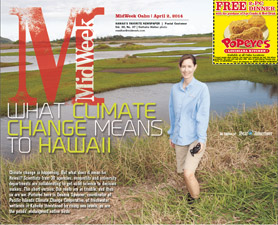What Climate Change Means To Hawaii
“Really, where a lot of that has gotten lost in the Islands is in that last step, the translation,” says Victoria Keener, lead principal investigator for the Pacific Regional Integrated Sciences & Assessments program.
“I think what all of us need to work on is where scientists write a paper and it gets stuck on a shelf or in a journal, and it never gets used to make a decision. It comes down to the people. Scientists can be very uncomfortable with people, so it is something we are trying to deal with, and it comes down to generating a trusting relationship with the people who make these decisions and getting the technical information to them.”
One area they have not found pushback from is local residents themselves. While working in the South and in Arizona, scientists such as Keener found that just the mention of climate change or environmental issues would have people run away screaming. Not so here in Hawaii.
“When I went back to my headquarters when I was working on erosion issues and the sedimentation of reefs, I told them, ‘You don’t have to tell Pacific Islanders that mud flows downhill after the rain,” says Helweg. “These are people who really understand that. They may not have the equations, but they know it gets muddy after rain. The people here in the Islands are very savvy, and it is coupling large-scale observation with small-scale studies together that will help us get a boundary around what is happening.”
Blending local knowledge with PICCC data is what gives Marra confidence that we can make headway here in the Islands.
“There is technical knowledge and there is experiential knowledge,” says Marra. “What we want to do is blend those two, so that we can frame technical knowledge in a way that relates to the folks’ experience – being pono about not just what we do, but how we do it.”
In the end, the science can help us with some with the hows and whys of what is happening to our Islands. But the significance of the science is not caught up in the variables of equations and the parabolic measurements of rainfall, but in our inherent knowledge of what makes Hawaii home.
“We are blessed with a mild climate. There are very few climate extremes here, and that has shaped not only the Native Hawaiian culture but all those who have settled here,” says Spooner. “As that climate changes, it will affect all of us. We need to think very deeply about those values that are most important to us to protect and conserve over time, as climate change is going to continue to change what we assume to be a pretty stable environment.
“We need to have that public dialogue, having it rooted in understanding of indigenous perspectives on how to adapt to changing conditions and the local community perspective. That is our greatest strength as a state: having the ability to bring in those different perspectives. The science is helpful, but we cannot forget the values of why it is that we care so deeply about these islands.”
Photos By Nathalie Walker







